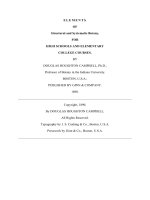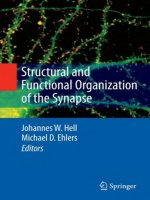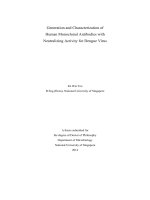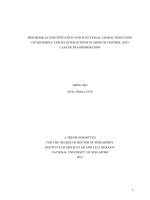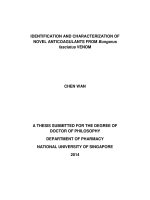Structural and epitope characterization of dust mites allergens, der f 13 and blo t 5
Bạn đang xem bản rút gọn của tài liệu. Xem và tải ngay bản đầy đủ của tài liệu tại đây (13.68 MB, 197 trang )
STRUCTURAL AND EPITOPE CHARACTERIZATION OF
DUST MITES ALLERGENS, DER F 13 AND BLO T 5
CHAN SIEW LEONG
NATIONAL UNIVERSITY OF SINGAPORE
2006
STRUCTURAL AND EPITOPE CHARACTERIZATION
OF DUST MITES ALLERGENS, DER F 13 AND BLO T 5
CHAN SIEW LEONG
(B. Sc., USM)
A THESIS SUBMITTED
FOR THE DEGREE OF DOCTOR OF PHILOSOPHY
DEPARTMENT OF BIOLOGICAL SCIENCES
NATIONAL UNIVERSITY OF SINGAPORE
2006
i
Acknowledgement
I would like to pay my greatest gratitude to my supervisor, Dr Henry Mok. His
guidance and tremendous passion in research have been a motivation to keep me
going throughout my PhD. Thank you in believing in me and giving me your trust. It
has been a great experience working with you.
Most of the work in this thesis would not be possible without close co-operation with
great mentor, colleagues and friends in the Functional Genomics Lab 3. A big thank
you to Dr Chew Fook Tim, Seow Theng, Tan Ching, Ken, Su Yin and Kavita for their
valuable advices. Without them, most of the immunological experiments would not be
possible.
It’s been great working in the Structural Biology Lab with all the exceptional people:
Yvonne, Xingfu, Yonghong, Mingbo, Gary, Olga, Anir, Jana, Deepti, Rika, Michelle,
Zheng Yu and Lin Zhi. Thanks for enduring my presence. Many experiments would
not be plausible with special advice and technical contribution from these excellent
scientists in NUS, namely Prof. Kini, Dr. Yang, Dr. Wang, Dr. Seah, Dr. Fan, Chye
Fong and Mr. Ow.
To Yvonne, thank you for always being here for me. You’re the greatest love I could
ever find. Life in Singapore has been exciting with all my friends here. My special
‘heavy credit’ to the Makan Marathon bunch, can’t wait to eat with you guys again.
Dearest Muddies, I have had absolutely spinning good time with you all. Ultimate
ii
Frisbee has been one of the greatest things to happen to me in Singapore. To Dario @
Picio and Oli, stay geeky
Special gratitude to Rick, Jasmine and little Reuben. It’s been a marvelous 5 years
being loved by all of you. You all are just wonderful. Dearest Dad, Mom and Kit Yee,
thanks for supporting me all these while. I have always wished that all of you could
be here with me all these while.
Last but not least, a tribute to Hema and Dawny. You girls are absolutely fantastic.
Half the thesis goes to both of you.
iii
Table of contents
Acknowledgement
Table of contents
Summary
List of figures
List of tables
List of abbreviations
i
iii
ix
xi
xiii
xiv
Chapter 1: Introduction
1.1 Allergy
1.1.1 Allergy: An Introduction
1.1.2 Mechanism of allergy
1.2 Dust mite, an important source of allergens
1.3 Structural and epitope characterization of allergens
1.3.1 Structural biology of allergens
1.3.2 IgE epitope mapping of allergens
1.4 Specific immunotherapy against allergy: Strategies to create
hypoallergen
1.5 Group 13 dust mite allergens
1.5.1 Group 13 dust mite allergens and fatty acid binding proteins
1.5.2 Der f 13, a newly characterized group 13 allergen from
Dermatophagoides farinae.
1.6 Blo t 5, a major allergen with coiled-coil structure from Blomia
1
1
4
9
13
13
17
20
25
25
28
31
iv
tropicalis
1.7 Nuclear Magnetic Resonance (NMR)
1.7.1 Basics of NMR
1.7.2 Multi-dimensional NMR and sequential assignment
1.7.3 Solution structure determination using NMR techniques
1.7.4 Preparation of NMR sample
1.8 Objectives of this study
34
34
36
39
41
43
Chapter 2: Materials and Methods
2.1 Generation and subcloning of Der f 13 and its mutants into
expression vector
2.1.1 Bacterial host strains
2.1.2 Generation of DNA insert and Polymerase Chain Reaction
2.1.3 Generation of DNA mutant insert for site directed
mutagenesis
2.1.4 Preparation of DH5-α competent cells
2.1.5 Sub-cloning
2.1.6 Transformation of ligation mix into DH5-α competent cells.
2.1.7 PCR screening of transformant
2.1.8 Isolation of DNA plasmid
2.1.9 Plasmid DNA sequencing
2.2 Protein expression and purification of Der f 13
2.2.1 Transformation of plasmid into BL21 (DE3) competent cells
2.2.2 Protein expression
2.2.3 Protein purification using Nickel-affinity chromatography
45
45
45
45
46
49
49
51
51
52
53
54
54
54
55
v
2.2.4 Protein purification using glutathione-sepharose affinity
chromatography
2.2.5 Thrombin digestion
2.2.6 Gel filtration FPLC
2.2.7 Preparation of NMR sample
2.2.8 Sodium Dodecyl Sulphate-Polyacrylamide Gel
Electrophoresis (SDS-PAGE)
2.2.9 Circular dichroism spectropolarimetry
2.2.10 Sequence alignment
2.3 Nuclear magnetic resonance and structural determination
2.3.1 NMR chemical shift assignments of Der f 13
2.3.1.1 2D
1
H-
15
N HSQC spectrum
2.3.1.2 HNCACB and CBCA(CO)NH
2.3.1.3 C(CO)NH-TOCSY and HC(CO)NH-TOCSY
2.3.1.4 HCCH-TOCSY
2.3.1.5
1
H-
13
C HSQC
2.3.2 NOE distance restraints and hydrogen bond restraints of
Der f 13
2.3.2.1 Hydrogen-deuterium exchange measurement
2.3.2.2
15
N-edited NOESY
2.3.2.3
13
C-edited NOESY
2.3.3 NOE assignments and structure calculation
2.4 Immunoassay
2.4.1 Specific IgE binding ELISA experiment
2.4.2 Inhibition ELISA experiment
56
56
57
57
58
58
59
60
60
60
61
62
62
63
64
64
64
65
65
67
67
68
vi
2.4.3 Skin prick test
2.4.4 Isolation of mononuclear cells using Ficoll-Hypaque gradient
centrifugation
2.4.5 PBMC proliferation and cytokine expression
2.4.6 Cytokines measurement
2.4.7 Mouse immunization
2.4.8 Mouse orbital bleeding and sera collection
2.4.9 Inhibition of human IgE binding to Der f 13 by specific
mouse IgG antibodies
2.4.10 Specific mouse IgG binding to Der f 13 ELISA experiment
2.4.11 Specific mouse IgE binding to Der f 13 ELISA experiment
2.4.12 Specific mouse IgG binding to human FABP ELISA
experiment
2.5 Sub-cloning, expression and purification of Blo t 5
2.6 NMR experiments and chemical shifts assignment of Blo t 5
68
69
70
70
71
71
72
73
74
74
75
75
Chapter 3: Structure characterization and IgE epitope mapping of Der f 13
3.1 Protein expression and purification
3.1.1 Expression and purification of His-tag Der f 13
3.1.2 Protein expression and purification of GST-tag Der f 13
3.1.3 Circular dichroism of Der f 13
3.2 NMR Structure of Der f 13
3.2.1 1D
1
H-NMR and 2D
1
H-
15
N HSQC spectra of Der f 13
3.2.2 Chemical shifts assignment of Der f 13
77
77
77
78
78
81
81
81
vii
3.2.2.1 Stereospecific assignment of methyl groups
3.2.2.2 Chemical shift index
3.2.3 Hydrogen bond restraints and TALOS torsion angle restraints
3.2.4 Automated NOE assignment by CYANA
3.2.5 Calculations of protein structure by CYANA and DYANA
3.3 Sequence analysis and putative IgE epitope prediction
3.3.1 Human FABPs neither bind IgE and nor react in skin prick
test
3.3.2 Sequence alignment of Der f 13 with human FABP
3.4 Site directed mutagenesis, IgE binding ELISA and skin prick
reactivity
3.4.1 IgE binding ELISA of Der f 13 single mutants
3.4.2 Reduced IgE binding of double mutants and triple mutants
3.4.3 Triple mutant 3A cannot inhibit binding of IgE to wild type
Der f 13
3.4.4 Skin prick reactivities of wild type sand triple mutant 3A of
Der f 13
3.4.5 Circular dichroism and gel filtration chromatography of wild
type and 3A mutant of Der f 13
3.4.6 IgE binding epitope site on Der f 13
3.5 PBMC proliferation and cytokine release
3.5.1 Isolation of PBMC from group 13 allergic patients
3.5.2 Stimulation of PBMC proliferation by Der f 13 and 3A
mutant
3.5.3 Cytokines release by wild type and 3A mutant of Der f 13
87
89
91
93
97
103
103
106
109
109
110
114
114
117
117
120
120
120
122
viii
3.6 Mouse immunization and generation of IgE blocking IgG
3.6.1 IgG and IgE production from mice immunized with wild type
or 3A mutant of Der f 13
3.6.2 3A mutant raised IgG blocks binding of human IgE to wild
type Der f 13
3.6.3 Binding of mouse sera IgG to group 13 isoforms
3.6.4 Binding of mouse sera IgG to human FABP
3.7 Hypoallergen immunotherapy: Th1 or Treg?
3.8 Charged residues: A preferred epitope residues for IgE ?
Chapter 4: Structure characterization of Blo t 5
4.1 Protein expression and purification of Blo t 5
4.2 Circular dichroism spectrum of Blo t 5
4.3 1D
1
H-NMR and 2D
1
H-
15
N HSQC spectra of Blo t 5
4.4 Backbone chemical shifts assignment and chemical shift index of Blo
t 5
127
127
128
130
130
132
135
140
140
142
143
146
Chapter 5: Conclusion
5.1 Structure and IgE epitope mapping of Der f 13 leading to
development of hypoallergenic mutant
5.2 Structure characterization of Blo t 5
5.3 Future direction
149
149
153
154
References
Appendix
157
175
ix
Summary
Dust mite has been one of the major causes of allergic diseases and asthma in the
world. The body parts and faeces of dust mites contain high amount of allergenic
proteins that can cause allergic reactions (Tovey et al., 1981). An allergic reaction
requires the cross-linking of IgE antibodies bound on the surface of the mast cells by
environmental allergenic molecules, and which leads to the release of pro-
inflammatory mediators that causes allergy symptoms. So far, the basis of interaction
between allergen and IgE antibodies are not well understood. Hence, structural
studies of allergens and their epitopes involved in the interaction with IgE are
extremely important in order to understand the characteristics of an allergen as well as
to develop hypoallergenic molecules for specific allergen immunotherapy.
In this thesis, we would like to describe a detailed structural study of Der f 13, a
group 13 allergen from dust mite Dermatophagoides farinae by using Nuclear
Magnetic Resonance spectroscopy as well as IgE epitope mapping of the allergen and
development of a hypoallergenic molecule as potential vaccine for immunotherapy.
High-resolution solution structure of Der f 13 was solved and was found to be highly
similar to homologous human fatty acid binding proteins (FABP). Although human
FABPs are highly similar to Der f 13 in terms of amino acid sequence and structure,
they do not bind to IgE or elicit any allergic reaction. Sequence alignment with human
FABP has revealed several unique surface charged residues on Der f 13 that may be
involved in IgE binding. Epitope residues have been confirmed by using site-directed
mutagenesis and IgE binding assays and mapped to 4 charged residues Glu-41, Lys-
63, Lys-91 and Lys-103. The side chains of these four residues are highly exposed on
x
the surface of the protein and located on two distinct sites at the opposite surface of
the protein. A triple mutant 3A (E41A_K63A_K91A) has been generated and shown
to have a significantly lower IgE binding and reduced skin prick reactivity. The 3A
mutant also showed similar PBMC proliferation induction as wild type Der f 13 and is
able to stimulate release of Th1 cytokines while at the same time reducing the
secretion of Th2 cytokines. Although the IgE epitopes of 3A mutant have been
removed, it is still able to stimulate production of mouse blocking IgG antibodies that
are able to inhibit the binding of patients’ sera IgE to wild type Der f 13. These
findings indicate that 3A mutant is a good hypoallergen candidate that can be used for
vaccine immunotherapy of Der f 13 allergy. Our observations also implied that
surface charged residues might play important role in IgE binding and thus allergenic
properties of allergens in general.
Structural characterization of an additional allergen Blo t 5, from Blomia
tropicalis has also been carried out using circular dichroism (CD) and NMR
spectroscopy. Blo t 5 is found to be comprised of mainly α-helices in its secondary
structure as observed in CD experiments. The backbone chemical shifts of Blo t 5
have also been assigned using 3D triple resonances NMR experiments. Three α-
helices separated by tight turns were observed in the chemical shift index (CSI) plot.
CSI has also revealed that the N-terminal region of Blo t 5 may be disordered and
contain no secondary structures.
xi
List of Figures
Figure 1.1
Mechanisms of allergic reaction
8
Figure 1.2
Structures of human FABP
27
Figure 1.3
Sequence alignment of Der f 13 with other homologous group 13
allergens
29
Figure 1.4
DNA sequence and translated amino acid sequence of Der f 13
30
Figure 1.5
Sequence of Blo t 5
33
Figure 2.1
Generation of site-directed mutants by PCR-based overlap
extension
47
Figure 2.2
List of primers used for PCR and mutagenesis studies
48
Figure 3.1
Expression and purification of His-tag Der f 13
79
Figure 3.2
Expression and purification of GST-tag Der f 13
79
Figure 3.3
Gel filtration profile and CD spectrum of Der f 13
80
Figure 3.4
One dimensional
1
H-NMR of Der f 13
83
Figure 3.5
1
H-
15
N HSQC of Der f 13
84
Figure 3.6
Sequential assignment of backbone chemical shifts of Der f 13
85
Figure 3.7
Side chain
13
C chemical shifts
86
Figure 3.8
Splitting pattern of different methyl groups
87
Figure 3.9
1
H-
13
C HSQC spectrum of Der f 13
88
Figure 3.10
Chemical shift index of Der f 13
90
Figure 3.11
Hydrogen bond restraints derived from hydrogen-deuterium
exchange experiment
92
Figure 3.12
Short and medium range NOEs
95
Figure 3.13
Assignment of
15
N-edited NOESY
96
Figure 3.14
Secondary structure topology of Der f 13
100
Figure 3.15
Solution structure of Der f 13
101
Figure 3.16
Surface diagram and hydrophobic core of Der f 13
102
Figure 3.17
Skin prick test on patient H3
105
xii
Figure 3.18
IgE binding for Der f 13 and human FABP
105
Figure 3.19
Sequence alignment of Der f 13 with human FABPs
107
Figure 3.20
IgE binding assay of Der f 13 single alanine mutants
112
Figure 3.21
IgE binding assay for double mutants and triple mutant 3A of
Der f 13
113
Figure 3.22
Inhibition of IgE binding by wild type and 3A mutant of Der f 13
116
Figure 3.23
Circular dichroism and gel filtration profiles of the wild type and
3A mutant of Der f 13
118
Figure 3.24
IgE binding epitope residues of Der f 13
119
Figure 3.25
PBMC proliferation by wild type and 3A mutant of Der f 13
121
Figure 3.26
Cytokine release profile of PBMC stimulated with wild type or
3A mutant of Der f 13
126
Figure 3.27
Mouse IgG and IgE titer
129
Figure 3.28
Inhibition of human IgE binding to Der f 13 by mouse blocking
IgG
129
Figure 3.29
Binding of mouse IgG to Der f 13, other group 13 isoforms, and
human FABPs
131
Figure 3.30
Regulation of T-cells during immunotherapy
134
Figure 4.1
Expression and purification of His-tag Blo t 5
140
Figure 4.2
Gel filtration profile of Blo t 5
141
Figure 4.3
Circular dichroism spectrum of Blo t 5
142
Figure 4.4
One dimensional
1
H-NMR spectrum of Blo t 5
144
Figure 4.5
1
H-
15
N HSQC spectrum of Blo t 5
145
Figure 4.6
Sequential assignment of backbone chemical shifts of Blo t 5
148
Figure 4.7
Chemical shift index of Blo t 5
148
xiii
List of Tables
Table 1.1
Classification of dust mite allergens
12
Table 1.2
List of allergen structures
16
Table 3.1
Structural statistics of Der f 13 solution structure
99
Table 3.2
Skin prick test for Der f 13, Der p 2 and human FABP
104
Table 3.3
Solvent accessibility of residues selected for mutagenesis in Der f
13
108
Table 3.4
Skin prick test of 3A mutant
115
Table 3.5
Analysis of charged amino acids of major allergens and their
human homologues
138
xiv
List of abbreviations
Amino acids
One letter code
Three letter code
Amino acid
A
Ala
Alanine
C
Cys
Cysteine
D
Asp
Aspartic acid
E
Glu
Glutamic acid
F
Phe
Phenylalanine
G
Gly
Glycine
H
His
Histidine
I
Ile
Isoleucine
K
Lys
Lysine
L
Leu
Leucine
M
Met
Methionine
N
Asn
Asparagine
P
Pro
Proline
Q
Gln
Glutamine
R
Arg
Arginine
S
Ser
Serine
T
Thr
Threonine
V
Val
Valine
W
Trp
Tryptophan
Y
Tyr
Tyrosine
xv
Chemicals and reagents
BSA
Bovine serum albumin
dATP
2’ deoxyadenosine 5’ triphosphate
dCTP
2’ deoxycytidine 5’ triphosphate
dGTP
2’ deoxyguanosine 5’ triphosphate
dNTP
Deoxyribonucleotide triphosphate
dTTP
2’ deoxythymidine 5’ triphosphate
EDTA
Ethylenediaminetetraacetic acid
IPTG
isopropyl –D-thiogalactoside
Ni
Nickel
Ni-NTA
Nickel-Nitrilotriacetic
PBS
Phosphate buffer saline
PBS-T
Phosphate buffer saline with 1% Tween
PNPP
p-Nitrophenyl phosphate disodium
SDS
Sodium dodecyl-sulphate
TEMED
N,N,N',N'-Tetramethylethylenediamine
TMB
3,3′,5,5′-Tetramethylbenzidine
Tris
Tris (hydroxymethyl)-aminomenthane
WST-1
2-(4-iodophenyl)-3-(4-nitrophenyl)-5-(2,4-disulfophenyl)-
2H-tetrazolium salt.
xvi
Units and measurement
Bp
base pair
Da
Dalton
Hz
Hertz
K
Kelvin
kDa
Kilo Dalton
M
Molar
pH
Potential of hydrogen
ppm
Parts per million
rpm
Rotation per minute
SGD
Singapore Dollar
U
Unit (enzyme)
V
Volt
Others
1D/2D/3D/4D
One dimensional/ Two dimensional/ Three dimensional/
Four dimensional
α
Alpha
β
Beta
γ
Gamma
δ
Delta
ε
Epsilon
APC
Antigen-presenting cell
CD
Circular dichroism
xvii
CSI
Chemical shift index
DNA
Deoxyribonucleic acid
ELISA
Enzyme-Linked ImmunoSorbent Assay
EST
Expressed Sequence Tag
FABP
Fatty acid binding protein
FcεRI
IgE receptor type-I
FPLC
Fast Protein Liquid Chromatography
GM-CSF
Granulocyte-macrophage colony-stimulating factor
GST
Glutathione S-transferase
HRP
Horseradish peroxidase
HSQC
Heteronuclear Single-Quantum Correlation
IFN-γ
Interferon gamma
IgA
Immunoglobulin A
IgE
Immunoglobulin E
IgG
Immunoglobulin G
IL
Interleukin
ITAM
Immunoreceptor tyrosine-based activation motif
LB
Luria Bertani
MHC
Major histocompatibility complex
NMR
Nuclear Magnetic Resonance
NOE
Nuclear Overhauser Effect
NOESY
Nuclear Overhauser Effect Spectroscopy
NPC2
Niemann Pick protein type C2
O.D.
Optical density
PBMC
Peripheral Blood Mononuclear Cells
xviii
PCR
Polymerase chain reaction
R.M.S.D.
Root mean square deviation
SDS-PAGE
Sodium Dodecyl-Sulphate Polyacrylamide Gel
Electrophoresis
SPT
Skin prick test
TCR
T cell receptor
TGF-β
Transforming growth factor beta
Th1
Type-1 Helper T Cells
Th2
Type-2 Helper T Cells
TNF-α
Tumor necrosis factor alpha
Treg
Regulatory T cells
TOCSY
Total correlation spectroscopy
WT
Wild type
1
Chapter 1: Introduction
1.1 Allergy
1.1.1 Allergy: An Introduction
Allergy is an immune disease when a predisposed allergic individual shows
increased sensitivity and abnormal immune response to foreign substances, which are
normally harmless to non-allergic patients. In a healthy individual, the immune
system plays a delicate role to balance the maximum protection from the harmful
invasion of foreign infection, while at the same time minimizing over-reaction against
self-antigens or non-harmful foreign substances. If this balance is not maintained, it
could lead to immune system disorders term as ‘Hypersensitivity’. Hypersensitivity
disorders include autoimmune disorders, in which immune system is targeted against
self-antigens, as well as diseases that result in uncontrolled reaction against non-
harmful environmental proteins (allergens) and microbes (Abbas and Lichtman,
2003). Hypersensitivity can be classified in 5 different types based on the pathologic
immune mechanisms and the components involved. Allergy is synonymous to the
term ‘immediate hypersensitivity type I’, which is an immunoglobulin E, IgE-
mediated immune response against foreign allergenic molecules.
Atopy is often a term used to describe IgE-mediated diseases. An atopic
patient is characterized by a hereditary predisposition to produce specific IgE
antibodies against environmental allergens and to develop strong immediate allergic
responses (Kay, 2001 and Abbas and Lichtman., 2003). Following the interaction
between allergens and specific IgE bound on the surface of mast cells or basophils,
pro-inflammatory mediators such as histamine and leukotrienes will be released,
2
triggering clinical expression of the diseases such as asthma, atopic eczema and
allergic rhinitis (Kay, 2001). Atopic status is usually demonstrated with a positive
skin prick test or elevated levels of specific serum IgE to the common allergens.
Substances that trigger and cause allergic reaction are commonly known as
allergens. Allergens are normally soluble proteins and they can be found at common
sources such as house dust mites, pollens, cats, nuts, bee venom and many more.
Allergens react with specific IgE antibodies, and when such antibodies are bound to
its receptor Fcε type I, it will trigger the release of pro-inflammatory mediators
resulting in allergic reaction. Majority of the allergens are involved in the primary
sensitization and the isotype switching to IgE synthesis. Generally, the sources of
allergens can be categorized into few major groups, such as pollen, mite, animal,
fungal, insect and food. Pollen allergens include those from grass such as rye grass
Lolium perenne and Timothy grass Phleum pratense; as well as those from tree
pollens such as birch (Betula verrucosa) and olive tree (Olea europaea) (Cromwell,
1997). The sources of mite allergen include house dust mites Dermatophagoides
pteronyssinus and Dermatophagoides farinae and storage mite Blomia tropicalis
remain as one of the main causes of allergy and asthma in the world (Arlian et al.,
2001). Animal allergens come from a wide range of mammals such as cats (Felis
domesticus), dogs (Canis familiaris), mice (Mus muscalaris), horses (Equus caballus)
and cows (Bos domesticus). Several genera are implicated as major fungal allergen
sources comprising Aspergillus, Cladosporium, Alternaria, Penicillium and Fusarium
(Cromwell, 1997). Honey bee (Apis mellifera) venom and cockroaches (Blatella
germanica and Periplaneta americana) are the main contributors of insect allergens
(Arruda et al., 2001). Food allergens include a wider range of sources such as shrimps
3
(Penaeus aztecus), chicken egg white, peanuts (Arachis hypogaea), cow milk and
meat.
In the last two decades, the incidences of allergy and asthma have increased
tremendously worldwide. A recent survey in United States has shown that 54.3% of
their population had positive skin prick test reaction to one or more allergens tested,
with an average of an individual reacting to 3 or 4 allergens tested (Arbes et al.,
2005). These figures are alarming as the numbers are already an underestimation as
only 10 crude allergens were used in this study. According to survey by World Health
Organization (WHO), there are 15-20 million asthma patients in India alone. A recent
study in Singapore reported about one in five of children of 2 years old suffers from
eczema and/or asthma (Tan et al., 2005). Allergy complications not only present a
major health problem but also give rise to significant financial loss attributed to
allergy, with around SGD$54 million spent per year in Singapore by asthmatic
patients (Chew et al., 1999).
Most of the clinical treatment for allergic diseases has been used to alleviate
the symptoms and to suppress the allergic inflammation. For examples, common
treatment for allergic rhinitis is through antihistamines drugs, anticholinergic agents
or topical corticosteroids (Kay, 2001). Atopic dermatitis is normally treated similarly
with topical therapy, antihistamines and corticosteroids to control and suppress
inflammation of the affected site (Roos et al., 2004). Anti asthmatic drugs such as
short- and long-acting β
2
-agonists such as salbutamol and salmeterol respectively,
remain of fundamental importance in the treatment to relieve asthma symptoms and
maintenance therapy (Kon et al., 1997). However, such pharmacological treatment
4
can only relieve the symptoms, but only allergen-specific immunotherapy can reverse
the course of the disease and provide protection against progression of allergic
diseases (Valenta, 2002 and Niederberger et al., 2004).
1.1.2 Mechanism of allergy
An allergic reaction would require at least three components, which are
allergen, IgE and at least one type of effector cells such as mast cells, basophils or
eosinophils (Abbas and Lichtman, 2003). However, the immune system requires other
cellular members such as antigen presenting cells (APC) and lymphocyte cells for
initiation and regulation of allergic reaction and disease progression. When an
allergen enters through epithelia, it will be captured by APC such as dendritic cells or
cutaneous Langerhans’ cells and presented as T-cell peptide to CD4+ T cells in a
major histocompatibility complex MHC class II-restricted manner (Abbas and
Lichtman, 2003 and Kay, 2001). CD4+ cells will be primed to differentiate into T
helper 2 cells (Th2) and releasing Th2-type cytokines such as IL-4, IL-5, IL-9 and IL-
13 (Kay, 2001).
The recognition of an antigen by T-cells requires presentation of the antigen
by the APC in the form of peptide fragments. These peptides, which contain T-cell
epitopes, will be loaded onto the MHC and the peptide-MHC complexes will be
displayed for recognition by T-cells. There are two classes of MHC molecules, with
class I MHC presents the peptides to the CD8+ cytolytic T cells while the class II
MHC presents the peptides to the CD4+ helper T cells. The class II MHC-peptide
5
complex will be recognized by the T cell receptor (TCR) on the surface of the T cells.
APCs that commonly initiate helper T cells are the dendritic cells, macrophages and B
lymphocyte cells. Dendritic cells and cutaneous Langerhans cells have been
implicated in asthma and eczema respectively by presenting allergens in a MHC class
II manner to Th2 cells (Kay, 2001).
Upon recognition of the MHC-peptide complexes, an array of cytokines will
be released by the Th2 cells. Th2 cells and its cytokines play an integral role in
controlling and intensifying an allergic reaction by increasing the production of IgE
antibodies and by increasing the development of inflammation cells such as mast
cells, basophils and eosinophils (see Figure 1.1 for illustration). Interleukins IL-4 and
IL-13 particularly promote B cells to undergo class switching of constant region of
immunoglobulin heavy chain to Fcε to produce IgE class antibodies, instead of other
class of antibodies (Valenta, 2002). IL-4 and IL-9 are involved in elevating the
development of mast cells, the key effector cells in releasing inflammation mediators
(Kay, 2001). IL-13 plays a key role in mediating airway hyper-responsiveness (Wills-
Karp et al., 1998) while the expansion and accumulation of eosinophils and basophils
are induced by IL-4, IL-5, IL-9 and IL-13 (Kay, 2001). The cytokines secreted each
by Th1 or Th2 cells were shown to act as autocrine growth factors to promote the
proliferation of these cells, and at the same time act as inhibitor for the growth of the
cells of the opposite type (Liew, 2002; Gajewski and Fitch, 1988; Fernandez-Botran
et al., 1988). IL-4 would induce the growth of Th2 cells, but at the same time would
inhibit the proliferation of Th1 cells. In contrast, IFN-γ, a cytokine released by Th1
subset of cells, is able to promote the expansion of Th1 cells but inhibit the
proliferation of Th2 cells.
